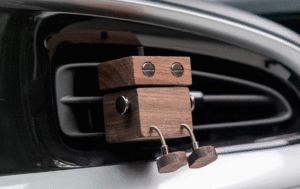Have you ever set up a reed diffuser only to find the scent disappears quickly or creates unexpected problems? Proper placement can make the difference between enjoying subtle, continuous fragrance or wasting your investment.
Reed diffusers should not be placed in direct sunlight, near heat sources, in high-traffic areas where they can be knocked over, near air vents or fans, or on valuable wooden surfaces. Incorrect placement can reduce diffuser effectiveness, create safety hazards, or damage furniture.
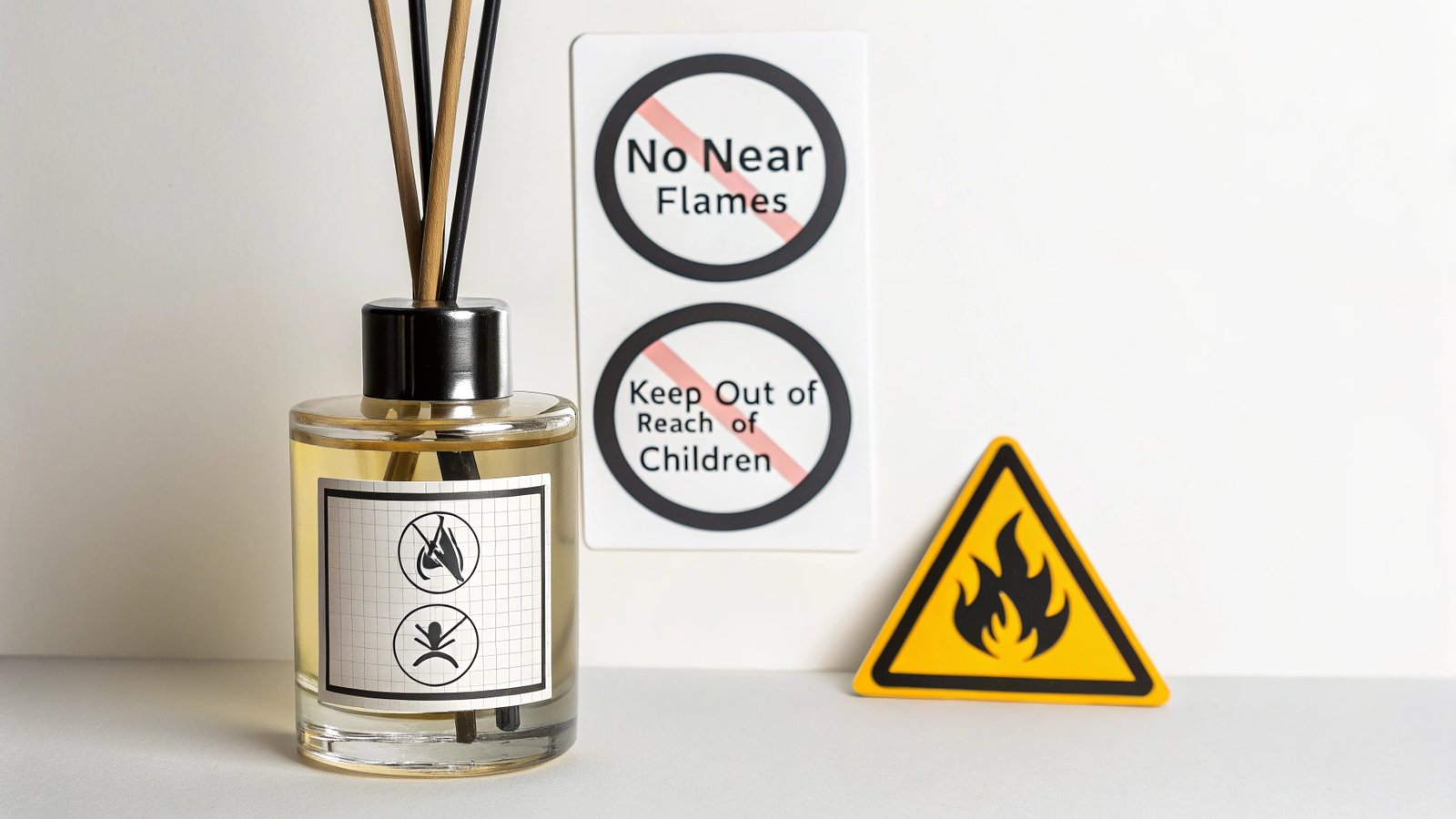
Understanding the do’s and don’ts of reed diffuser placement will help you maximize fragrance performance while preventing potential damage to your home. Let’s explore the key locations to avoid when positioning your diffuser.
Why Does Reed Diffuser Placement Matter So Much?
Have you noticed inconsistent fragrance from your diffuser or found it depleting faster than expected? The science behind reed diffusers makes proper positioning crucial to their function.
Reed diffuser placement significantly affects performance because these devices rely on capillary action and natural air currents to disperse fragrance, with improper locations causing accelerated evaporation, reduced scent throw, or potential safety hazards.
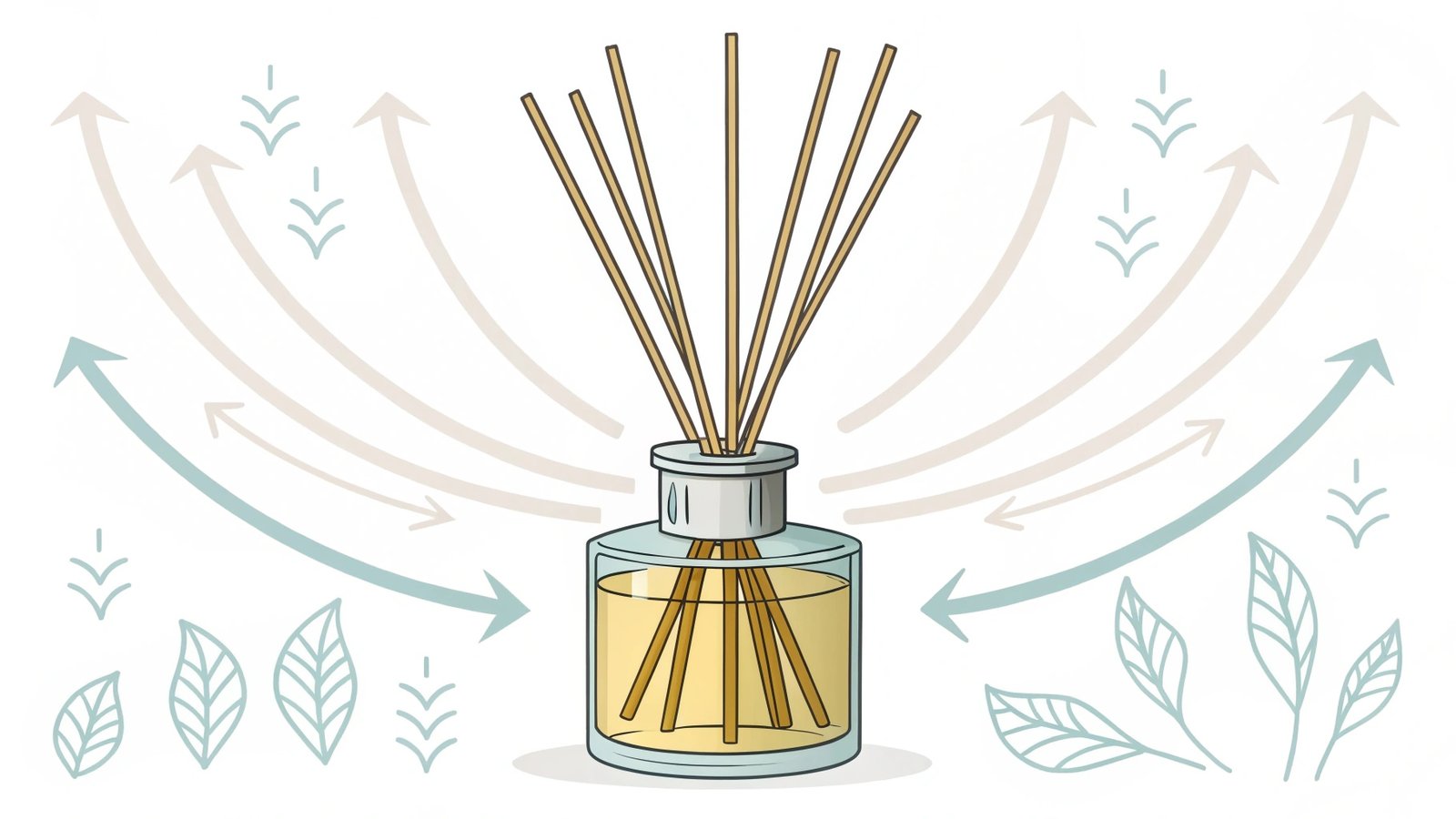
The Science of Reed Diffuser Performance
After years of developing and testing reed diffusers for global markets, I’ve gained deep insights into the factors that impact their performance. The effectiveness of a reed diffuser depends on a delicate balance of environmental conditions:
| Factor | Impact | Optimal Condition |
|---|---|---|
| Air Temperature | Higher temperatures accelerate evaporation | 65-75°F (18-24°C) |
| Air Movement | Moderate airflow enhances diffusion | Gentle natural circulation |
| Humidity | Lower humidity increases evaporation rate | 40-60% relative humidity |
| Container Design | Affects surface area and evaporation | Narrow-necked vessels with proper reed count |
| Oil Formulation | Determines viscosity and capillary action | Balanced for climate conditions |
When we developed our signature reed diffuser line, we conducted extensive testing in different environments. One surprising discovery was that the same diffuser placed in different locations within the same room could have a 30-40% difference in longevity and scent throw.
The physics behind reed diffusers is fascinating: the porous reeds contain thousands of microscopic channels that draw the scented oil upward through capillary action. As the oil reaches the exposed portion of the reeds, it evaporates into the surrounding air. This process relies on natural air currents to disperse the fragrance molecules throughout your space.
Improper placement can dramatically disrupt this delicate system, causing everything from accelerated evaporation (wasting your diffuser) to insufficient scent distribution (reducing your enjoyment).
Should You Put Reed Diffusers Near Windows or Direct Sunlight?
Does that sunny windowsill seem like the perfect spot for your new reed diffuser? Think again—sunlight creates more problems than you might realize for these sensitive fragrance systems.
Reed diffusers should never be placed in direct sunlight or near windows with strong light exposure, as UV rays and heat accelerate oil evaporation, potentially altering the fragrance composition and significantly reducing the diffuser’s lifespan.
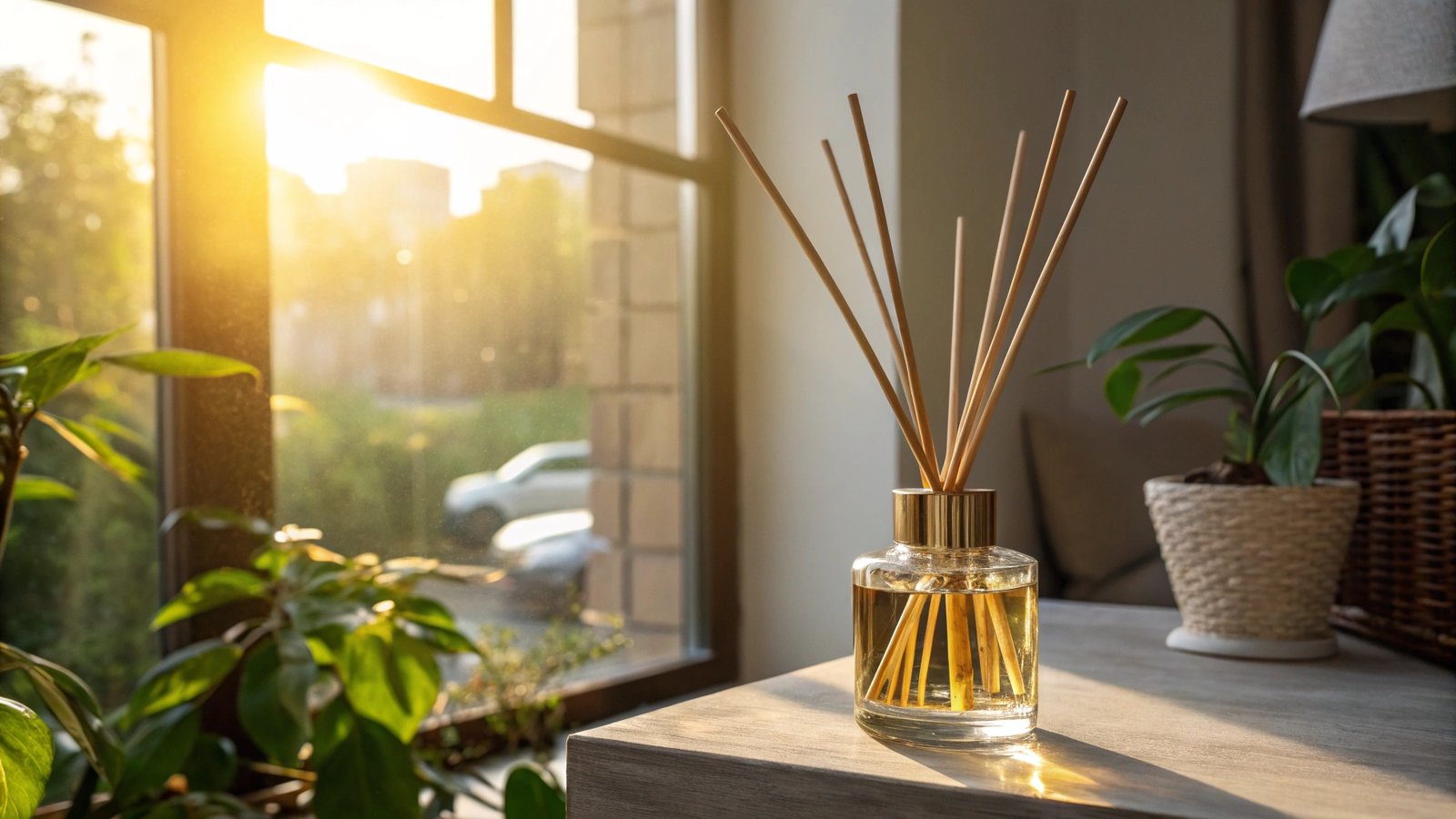
How Sunlight Damages Reed Diffusers
During our product development at ENO, we conducted controlled tests exposing identical reed diffusers to different lighting conditions. The results were striking:
| Placement | Oil Evaporation Rate | Lifespan Reduction | Fragrance Impact |
|---|---|---|---|
| Direct Sunlight | Up to 3x faster | 60-70% shorter lifespan | Significant fragrance degradation |
| Bright Indirect Light | 1.5x faster | 30-40% shorter lifespan | Moderate fragrance alteration |
| North-facing Window | Minimal increase | 10-15% shorter lifespan | Minimal impact |
| Away From Windows | Normal | Full expected lifespan | Preserved fragrance integrity |
The damage from sunlight is twofold: first, the heat accelerates evaporation, causing your diffuser to deplete much faster than intended. Second, and perhaps more concerning, UV radiation can break down the molecular structure of fragrance compounds, altering the carefully balanced scent profile.
I recall visiting a customer who had placed three identical diffusers in different locations in her home. The one on the sunny windowsill not only depleted in half the time but also developed a noticeably different scent profile—the delicate top notes had degraded, leaving only the heavier base notes behind.
This sunlight exposure can also affect the aesthetics of your diffuser, potentially discoloring both the oil and the container. With premium reed diffusers often costing $30-$100, protecting your investment from sun damage makes good financial sense.
Instead of windowsills, place your diffuser in locations with consistent, moderate temperature and minimal direct light exposure to preserve both its longevity and fragrance integrity.
Is It Safe to Place Reed Diffusers Near Electronics or Heat Sources?
Do you have limited counter space and find yourself considering placing your reed diffuser near appliances? This common placement choice creates several significant risks.
Never place reed diffusers near electronics, radiators, heating vents, or appliances, as the heat accelerates evaporation while creating potential fire hazards, and oil spills can damage electronic components or even create electrical shorts.
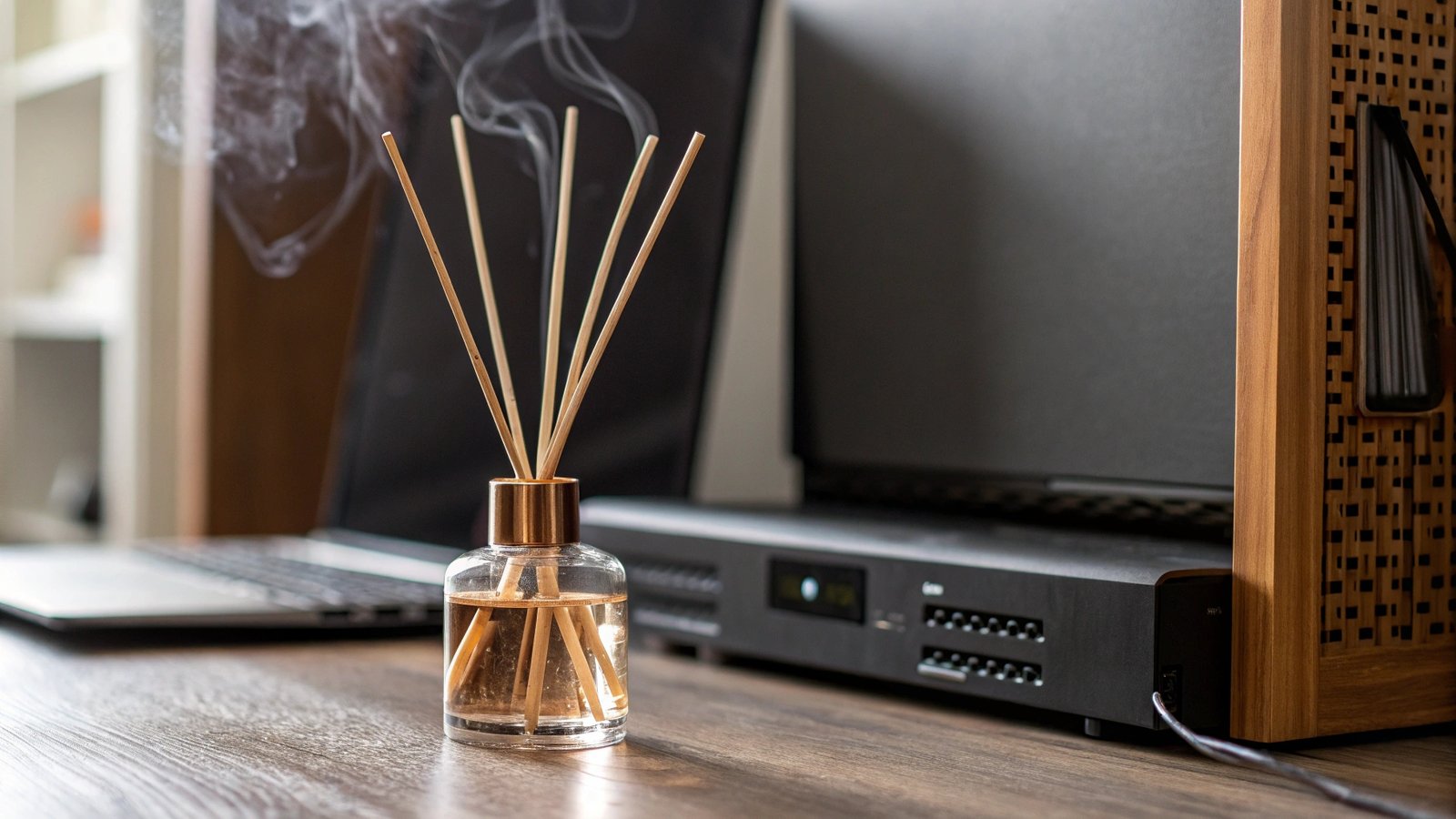
The Dangers of Heat Sources and Electronics
Through our safety testing and customer feedback over 15 years in business, we’ve identified several critical risks when diffusers are placed near heat sources or electronic equipment:
| Heat Source | Risk Level | Primary Concerns |
|---|---|---|
| Radiators | Very High | Accelerated evaporation, fire hazard if knocked over |
| Heating Vents | High | Uneven fragrance distribution, rapid oil depletion |
| Kitchen Appliances | High | Fire risk, oil contamination of food preparation areas |
| Computers/TVs | Medium | Electronic damage from spills, altered scent from equipment heat |
| Lamps | Medium | Accelerated evaporation, potential fire hazard |
| Candles | Extreme | Direct fire hazard, dangerous chemical mixing if spilled |
The alcohol content in many reed diffuser oils is flammable, creating a fire risk when placed near heat sources. Even more concerning is the potential for electronic damage—the oils used in reed diffusers are typically conductive and can cause short circuits if spilled onto electronic components.
One of our corporate clients learned this lesson the hard way when an office reed diffuser placed near a computer was accidentally knocked over, resulting in damage to expensive equipment and lost productivity. The repair costs far exceeded the price of the diffuser.
Beyond safety concerns, heat significantly impacts diffuser performance. In controlled tests, we found that a reed diffuser placed near a heating vent depleted up to 2.5 times faster than normal while producing an inconsistent and often overpowering scent profile.
For optimal safety and performance, keep reed diffusers at least three feet away from any heat sources and electronic equipment, and always place them on stable surfaces where they’re unlikely to be knocked over.
Should You Put Reed Diffusers in Areas with High Air Movement?
Have you positioned your diffuser near a fan or air vent hoping to spread the fragrance further? This common misconception actually undermines the diffuser’s effectiveness.
Reed diffusers should not be placed near ceiling fans, air conditioning vents, or drafty doorways, as excessive air movement causes uneven and accelerated evaporation, substantially reduces diffuser lifespan, and can create overwhelming scent in some areas while leaving others unscented.
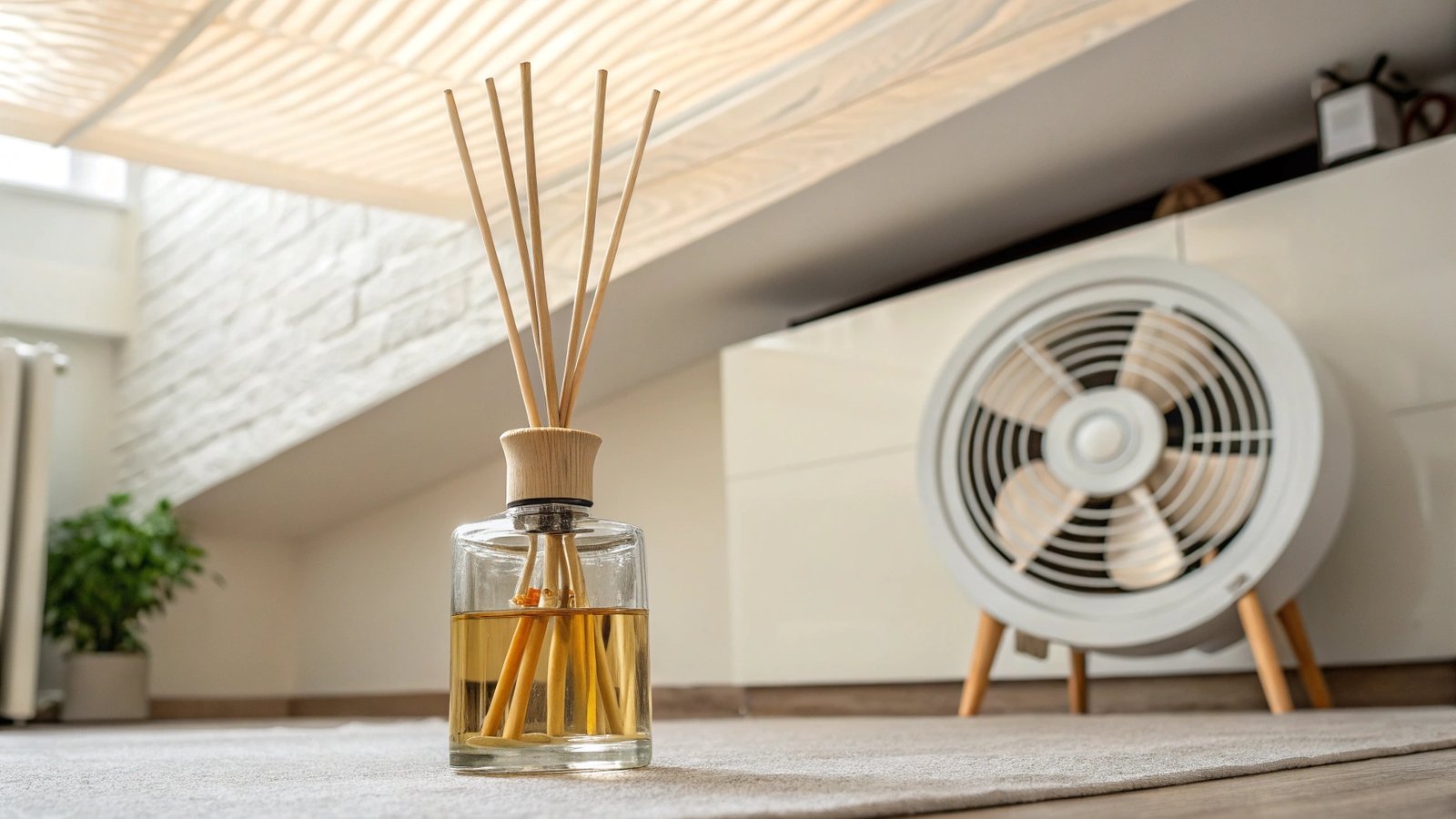
How Air Movement Affects Reed Diffuser Performance
At ENO, we’ve extensively researched how airflow impacts diffuser performance. Our findings reveal the complex relationship between air movement and fragrance dispersion:
| Airflow Condition | Effect on Evaporation | Scent Impact | Recommendation |
|---|---|---|---|
| High (near fans/vents) | Dramatically increased | Erratic, often too strong then absent | Avoid completely |
| Moderate (natural room circulation) | Slightly increased | Optimal dispersion | Ideal placement |
| Low (enclosed spaces) | Reduced | Limited to immediate area | Consider reed count increase |
| Drafty (doorways/windows) | Uneven and unpredictable | Inconsistent performance | Find more sheltered location |
While some air movement helps distribute fragrance throughout a space, excessive airflow disrupts the capillary action that reed diffusers rely on. When air moves too quickly across the reeds, it creates several problems:
- The oil evaporates primarily from one side of the reeds
- Evaporation occurs much faster than intended
- The scent is blown away before it can properly disperse
- Fragrance molecules become concentrated in some areas while absent in others
During product testing for a hotel client, we placed identical diffusers in various locations. The diffuser near the air conditioning vent depleted nearly three times faster than others while delivering inconsistent fragrance—overwhelming when the system was running and barely noticeable when it was off.
The ideal placement allows for gentle, natural air circulation that helps the fragrance disperse evenly without accelerating evaporation. Look for locations with moderate air movement, away from direct airflow sources like vents, fans, and frequently opened doors or windows.
If you must use air conditioning or fans in the same room as your diffuser, try to create a protected location where the diffuser won’t experience direct airflow—perhaps on a shelf with some surrounding objects to buffer the draft without blocking scent dispersion.
Can Reed Diffusers Damage Furniture or Surfaces?
Have you ever noticed a mysterious ring or discoloration under your diffuser? This common but preventable damage can affect valuable furniture and surfaces.
Reed diffusers should never be placed directly on polished wood, painted surfaces, or natural stone without a protective tray, as the oils can leak or spill, potentially causing permanent staining, finish damage, discoloration, or etching of vulnerable surfaces.
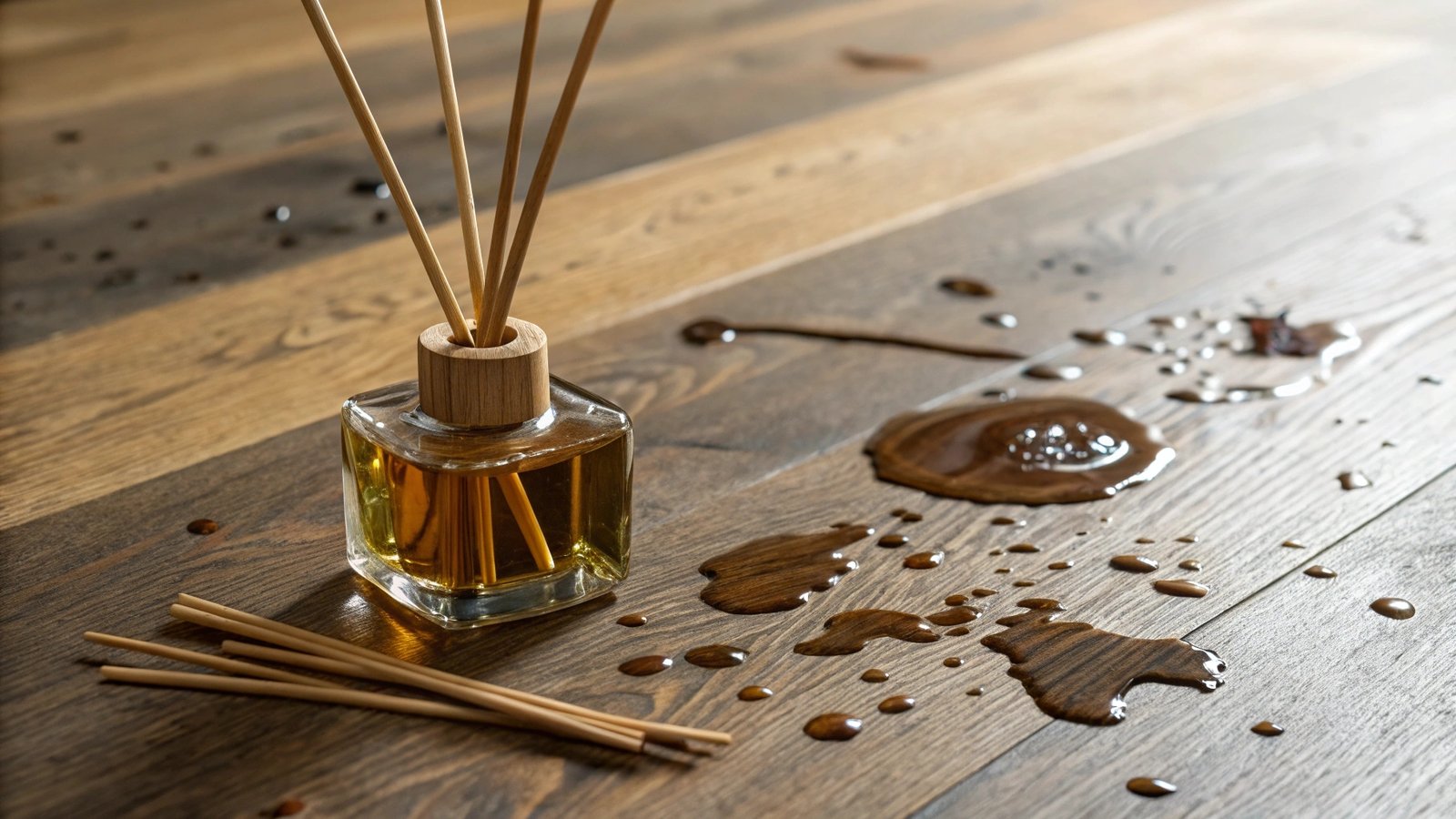
Protecting Your Surfaces from Oil Damage
Through our customer service department, surface damage consistently ranks among the top complaints related to reed diffusers. Here’s what we’ve learned about preventing this issue:
| Surface Type | Vulnerability Level | Type of Damage | Protection Method |
|---|---|---|---|
| Polished Wood | Very High | Staining, finish damage, discoloration | Coaster or tray with raised edges |
| Natural Stone (marble, granite) | High | Etching, oil penetration, discoloration | Non-porous tray, avoid porous stone |
| Painted Surfaces | Medium to High | Discoloration, paint softening | Hard protective surface |
| Plastic/Laminate | Low to Medium | Potential discoloration | Simple coaster suffices |
| Glass/Metal | Low | Minimal risk, though cleaning may be needed | Optional protection |
The risk comes not just from catastrophic spills but also from the subtle accumulation of oil that can occur at the base of the diffuser. As reeds are flipped or replaced, tiny droplets often fall onto the surface below. Over time, these small amounts of oil can penetrate finishes and create damage.
In one memorable case, a customer placed an expensive designer diffuser directly on an antique mahogany sideboard. The slow seepage of oil through the base created a permanent ring that required professional furniture restoration—far exceeding the cost of the diffuser itself.
To protect your surfaces:
- Always use a dedicated diffuser tray with raised edges to contain any potential leakage
- Choose trays made of non-absorbent materials like ceramic, glass, or metal
- Periodically check and clean underneath your diffuser to prevent buildup
- When flipping reeds, do so over a sink or protected surface to catch drips
- Consider double-protection for especially valuable surfaces
We’ve incorporated leak-resistant designs in our premium diffusers, including tight-fitting stoppers and non-drip reed insertion points, but even the best designs can’t eliminate all risk—especially if a diffuser is knocked over.
With proper protection, you can enjoy your reed diffuser without worrying about damage to your cherished surfaces.
Are There Rooms Where Reed Diffusers Shouldn’t Be Used?
Have you assumed reed diffusers work equally well in any room? Certain spaces in your home may actually be inappropriate for this type of fragrance delivery.
Reed diffusers should not be used in very small enclosed bathrooms, nurseries, rooms where food is prepared or consumed, areas with valuable artwork or documents, or spaces where pets such as birds or small mammals are kept.
![]()
Room-Specific Considerations for Diffuser Placement
Throughout my career developing home fragrance products, I’ve gathered substantial data about room appropriateness for different scenting methods:
| Room Type | Suitability | Primary Concerns | Alternatives |
|---|---|---|---|
| Small Bathrooms | Poor | Humidity variations, overwhelming in small space | Room sprays, small sachets |
| Kitchens | Poor | Food flavor interference, oil contamination risk | Specialized kitchen fresheners |
| Nurseries | Not Recommended | Potential respiratory sensitivity in infants | Unscented air purifiers |
| Dining Rooms | Poor near eating areas | Interferes with food enjoyment | Candles (when dining only) |
| Art Storage/Display | Avoid | Oil particles may settle on artwork | None needed; maintain clean air |
| Pet Areas (birds, rodents) | Dangerous | Potential toxicity to sensitive animals | Pet-safe specific products |
The concentration of fragrance oils in reed diffusers can become overwhelming in very small spaces, particularly those with poor ventilation. This not only creates an unpleasant sensory experience but can potentially trigger respiratory sensitivity in some individuals.
Kitchens present a particular challenge because food flavors and aromas can be affected by ambient fragrance. Additionally, the airborne oil particles from diffusers can potentially settle on food preparation surfaces. If you want to scent your kitchen, consider time-limited methods like room sprays that can be used when cooking isn’t taking place.
For homes with artwork, valuable documents, or collections, be aware that the oils dispersed by reed diffusers can, over time, settle on surfaces. While the amount is minimal, it may affect sensitive materials over the long term.
Perhaps most importantly, some reed diffuser oils contain compounds that can be harmful to certain pets—particularly birds and small mammals with sensitive respiratory systems. Always check with your veterinarian before using any scenting products in areas where pets spend significant time.
Instead of avoiding fragrance entirely in these spaces, consider alternative methods:
- Timed electronic diffusers that run only when appropriate
- Room sprays used occasionally when rooms are unoccupied
- Specialized products formulated for specific environments
Conclusion
To maximize reed diffuser performance and safety, avoid placing them in direct sunlight, near heat sources or electronics, in high airflow areas, directly on valuable surfaces without protection, or in unsuitable rooms like kitchens and nurseries.
About ENO
ENO is a leading professional manufacturer dedicated to the research and development of aromatic products. Specializing in scented candles, therapeutic-grade essential oils, reed diffusers, room sprays, and other fragrance solutions, we are committed to delivering high-quality products to meet diverse global needs.
With over 17 years of experience, we export to over 200 countries and regions worldwide. Each year, we supply a large volume of products to North America, Europe, Australia, Japan, South Korea, and Southeast Asia. Our company has established collaborations with globally renowned brands such as MCM, BLUE JACAR, and COZY.
Serving over 1,000 Amazon sellers annually, ENO stands out for its strength in technology, design, and product development. Our team of designers is internationally skilled, bringing ideas from creative design to product research and development, ensuring seamless production. We offer a complete set of solutions, providing products that reflect cutting-edge trends and deliver international competitive value to our clients.

